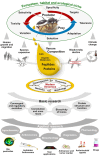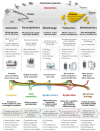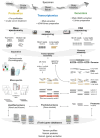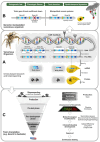Modern venomics-Current insights, novel methods, and future perspectives in biological and applied animal venom research
- PMID: 35640874
- PMCID: PMC9155608
- DOI: 10.1093/gigascience/giac048
Modern venomics-Current insights, novel methods, and future perspectives in biological and applied animal venom research
Abstract
Venoms have evolved >100 times in all major animal groups, and their components, known as toxins, have been fine-tuned over millions of years into highly effective biochemical weapons. There are many outstanding questions on the evolution of toxin arsenals, such as how venom genes originate, how venom contributes to the fitness of venomous species, and which modifications at the genomic, transcriptomic, and protein level drive their evolution. These questions have received particularly little attention outside of snakes, cone snails, spiders, and scorpions. Venom compounds have further become a source of inspiration for translational research using their diverse bioactivities for various applications. We highlight here recent advances and new strategies in modern venomics and discuss how recent technological innovations and multi-omic methods dramatically improve research on venomous animals. The study of genomes and their modifications through CRISPR and knockdown technologies will increase our understanding of how toxins evolve and which functions they have in the different ontogenetic stages during the development of venomous animals. Mass spectrometry imaging combined with spatial transcriptomics, in situ hybridization techniques, and modern computer tomography gives us further insights into the spatial distribution of toxins in the venom system and the function of the venom apparatus. All these evolutionary and biological insights contribute to more efficiently identify venom compounds, which can then be synthesized or produced in adapted expression systems to test their bioactivity. Finally, we critically discuss recent agrochemical, pharmaceutical, therapeutic, and diagnostic (so-called translational) aspects of venoms from which humans benefit.
Keywords: antivenom; bioassays; envenomation; evolution; genomics; modern venomics; spatial -omics; toxin production; translational research; venom.
© The Author(s) 2022. Published by Oxford University Press GigaScience.
Conflict of interest statement
The authors declare that they have no competing interests.
Figures







References
-
- Holford M, Daly M, King GF, et al. Venoms to the rescue. Science. 2018;361(6405):842–4. - PubMed
-
- Fry BG, Roelants K, Champagne DE, et al. The toxicogenomic multiverse: convergent recruitment of proteins into animal venoms. Annu Rev Genomics Hum Genet. 2009;10(1):483–511. - PubMed
-
- Casewell NR, Wüster W, Vonk FJ, et al. Complex cocktails: the evolutionary novelty of venoms. Trends Ecol Evol. 2013;28(4):219–29. - PubMed
Publication types
MeSH terms
Substances
LinkOut - more resources
Full Text Sources

